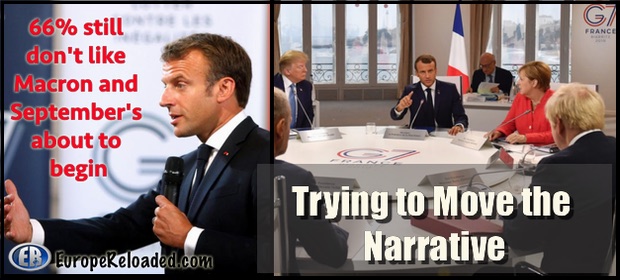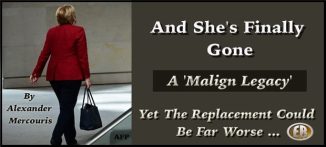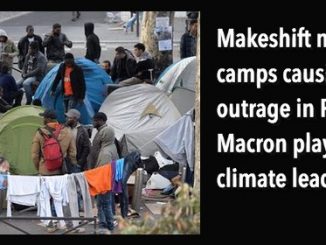
ER Editor: Le Journal du Dimanche, cited below, is actually putting a very positive spin on this polling result, noting that Macron has held steady through the summer (well, everyone’s been on holiday) and has even increased his polling results by a couple of points. The title says that Macron has the same level of popularity as last summer, meaning before the Gilets Jaunes started their weekly protests: SONDAGE. Emmanuel Macron retrouve sa popularité d’il y a un an. The Gilets Jaunes will be getting going again very soon, once the schools return.
********
Poll: Two-thirds of French unhappy with Macron
Two-thirds of French voters are not happy with the way President Emmanuel Macron is running the country, a poll on Sunday revealed.
FREEWEST MEDIA
Of those surveyed by pollster Ifop for the conservative weekly Le Journal du Dimanche (JDD) only 34 percent said they were “satisfied” with Macron’s presidency, compared with 66 percent who said they were “dissatisfied”.
Macron’s approval rating dropped to 23 percent in December 2018, when the Yellow Vest movement reached its peak. His rating matched that of his predecessor François Hollande’s in late 2013, then viewed as the most unpopular leader in modern French history
 The pollster interviewed 988 people between August 21 and 22, following nine months of ongoing social unrest, with weekly protests held by the Yellow Vests against the Macron administration.
The pollster interviewed 988 people between August 21 and 22, following nine months of ongoing social unrest, with weekly protests held by the Yellow Vests against the Macron administration.
The first Yellow Vest protests were held in mid-November last year against planned fuel tax hikes but quickly transformed into a broad social movement against the Macron government. The president is perceived as too arrogant and indifferent to voters’ daily concerns.
In June, Prime Minister Edouard Philippe announced that Macron’s social benefit and pension reforms would be relaunched as Act II. “We will maintain the possibility to retire at 62, but we will define a pivot age and incentives to work longer,” he said.
But the pension and unemployment benefits reforms both potentially remain controversial issues that could reboot Yellow Vest momentum.
At the end of the G7, which was held in the French coastal city of Biarritz, Brazil rejected the $20 million emergency aid promised by the G7 to counter fires in the Amazon. The refusal came in the wake of particularly intense exchanges between Brazilian President Jair Bolsonaro and Emmanuel Macron.
Thus Macron’s efforts to refocus media attention on Iran and Brazil and away from domestic issues have not succeeded.
G7 alerts are becoming less and less popular with those who pay for them. After the outbreak of a Franco-Brazilian crisis surrounding, in particular, fires in the Amazon, it was also China’s turn to put the group leaders in its place on the Hong Kong issue, reported 20 Minutes.
The actual G7, measured by nominal GDP, are: US (1), China (2), Japan (3), Germany (4), UK (5), France (6), India (7). But when measured by GDP in Purchase Power Parity, the list is different, with China in first place, followed by the US, India, Japan, Germany, Russia and Indonesia.
At the G7 meeting in Biarritz, the USA (2nd), Japan (4th), Germany (5th), UK (9th), France (10th), Italy (12th) and Canada (17th) were however represented.
CONTINUE READING HERE

••••
The Liberty Beacon Project is now expanding at a near exponential rate, and for this we are grateful and excited! But we must also be practical. For 7 years we have not asked for any donations, and have built this project with our own funds as we grew. We are now experiencing ever increasing growing pains due to the large number of websites and projects we represent. So we have just installed donation buttons on our websites and ask that you consider this when you visit them. Nothing is too small. We thank you for all your support and your considerations … (TLB)
••••
Comment Policy: As a privately owned web site, we reserve the right to remove comments that contain spam, advertising, vulgarity, threats of violence, racism, or personal/abusive attacks on other users. This also applies to trolling, the use of more than one alias, or just intentional mischief. Enforcement of this policy is at the discretion of this websites administrators. Repeat offenders may be blocked or permanently banned without prior warning.
••••
Disclaimer: TLB websites contain copyrighted material the use of which has not always been specifically authorized by the copyright owner. We are making such material available to our readers under the provisions of “fair use” in an effort to advance a better understanding of political, health, economic and social issues. The material on this site is distributed without profit to those who have expressed a prior interest in receiving it for research and educational purposes. If you wish to use copyrighted material for purposes other than “fair use” you must request permission from the copyright owner.
••••
Disclaimer: The information and opinions shared are for informational purposes only including, but not limited to, text, graphics, images and other material are not intended as medical advice or instruction. Nothing mentioned is intended to be a substitute for professional medical advice, diagnosis or treatment.




